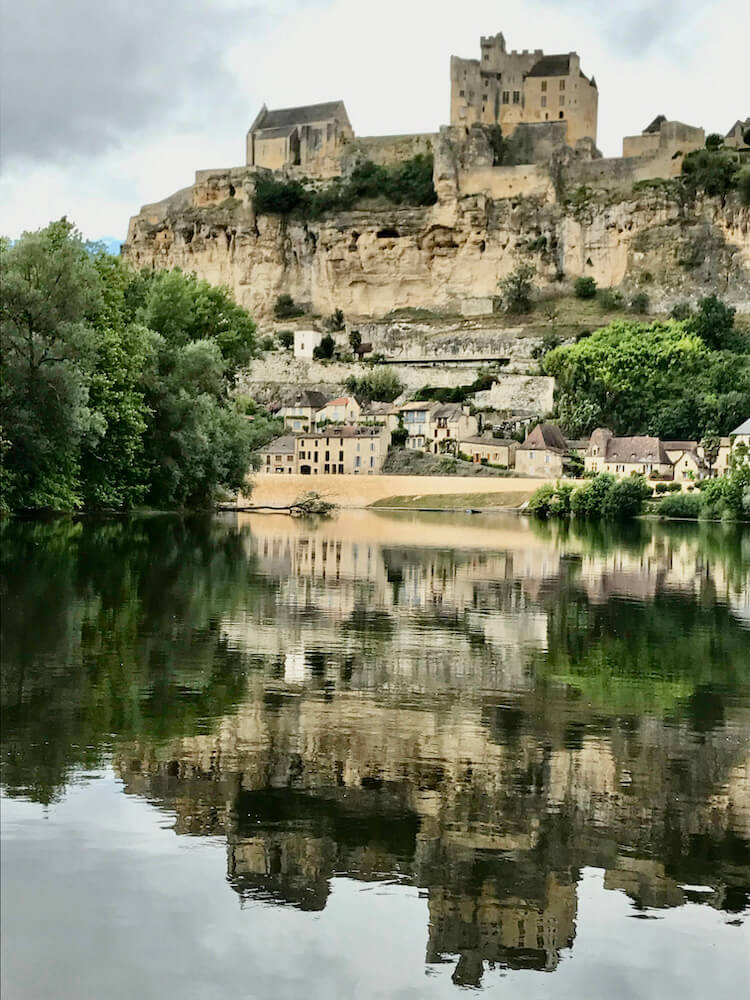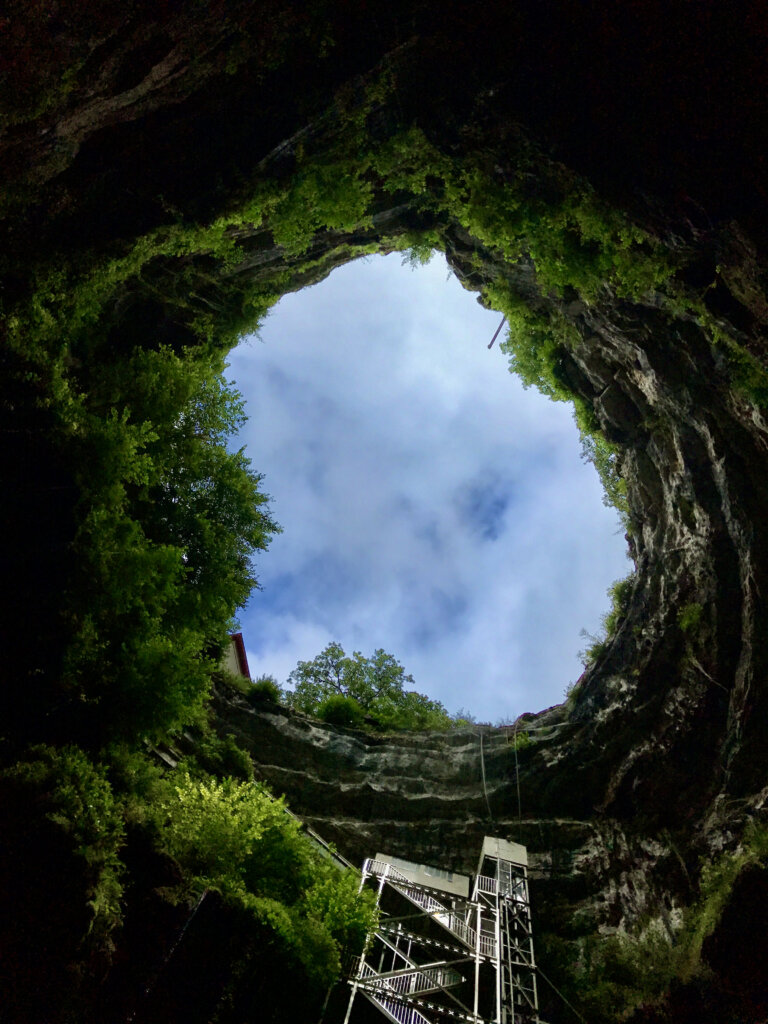Château de Beynac is a jewel of the Dordogne in southwestern France. With homes carved into cliffs, ancient cave paintings, float trips down the scenic Dordogne river, and—of course—fois gras and duck confit everywhere, you could happily spend weeks in this very special region.
But if you have just a few days, as we did after our visits to Chartres and Paris, here’s one approach for what to see and do to catch the highlights.
Visit Château de Beynac
Where to Stay in the Dordogne
We stayed in a beautiful little apartment in tiny Castels, minutes from Saint Cyprien, just an 11-minute drive to the castle.
However, since that apartment is no longer available, I recommend you stay in Sarlat-la-Canada, a beautiful historic town with a great market, just a 16 minute drive to Chateau de Beynac.
This one bedroom luxury flat in the medieval city center is absolutely stunning and a steal for the price. It offers views galore, a gourmet kitchen. It oozes romantic French ambiance but has all the modern amenities!
Check price and availability at the luxury flat in Sarlat center here.
This incredible stone fortress has been dominating the region since the 12th century and is one of the best preserved castles around.
The idea was that anyone considering an attack would be discouraged by the challenge of scaling the high cliff face where the castle was built.

The Romanesque keep is the oldest part of the castle. You’ll also see a residence off to the side which was renovated and enlarged in the 16th and 17th centuries.
Today, you can still see the painted ceiling from the 17th century and 15th century frescos on the carved Renaissance fireplace.
But keep walking! You don’t want to miss this view of the Dordogne Valley from the watch tower after you climb all those well-worn stone steps…
Chateau de Beynac has been a popular location to shoot many French films since the 1960’s. Plus, portions of the the movie Chocolat in 2000 were filmed in the village here.
How to access the chateau: If you’re driving here, just follow the signs to the top of the village of Beynac-et-Cazenac for parking. It’s just a one minute walk from there.
Or if you’re up from a steep climb, it’s a 20 minute walk from the lower part of the village of Beynac-et-Cazenac through the streets up to the castle. You can purchase tickets online here.
How to Rent a Car in the Dordogne
Discover Cars has no hidden fees, 24/7 customer service, and free cancellation. They search all the major rental car companies so you don’t have to.
Check price and availability on rental cars here.
Float the Dordogne River
The perfect thing to do after your visit to the château is to enjoy the view looking back at it from the other side on the river.
You have two options for your time on the calm and lovely Dordogne River.
If it’s a gorgeous summer day and you’re feeling like a bit of activity to work off last night’s feast, then rent a canoe for a self-guided paddle.
The most scenic nine miles—between Vitrac and Beynac— will take you between 2 and 2.5 hours at leisurly pace.
Since it was a misty, rainy day when we were there, we decided on option two, which was a boat cruise down the river.
You can catch the boat for a 50-minute river cruise to Castelnaud riverside, just across from Chateâu Beynac.

On the cruise, you’ll past several lovely castles, including Château de Castelnaud.
While not as grand as Chateâu de Beynac, it’s got some great history, too.
For instance, during the 100 Years War, Château de Castelnaud was owned by the English and Chateâu Beynac was owned by the French…so you can imagine the battles as they stared each other down across the river.
Today, Castelnaud is owned by an American family.
Finish up this beautiful day with dinner in nearby Dôme, perched high on a cliff or nearby scenic La Roque-Gageac.
Read more on France travel:
• 15 beautiful villages in Provence
• Off-the-beaten track Europe
Explore a Medieval Town
Sarlat-la-Canada is a medieval town with a phenomenal open air market on Wednesdays and Saturdays so plan your itinerary accordingly.
I always include a market visit on trips to Europe, whether I’m cooking in Tuscany or on my way to see the D-Day beaches in Normandy. And Sarlat didn’t disappoint.
We chatted about local pastry specialties with bakers and sampled olives, nuts, and cheeses. (Oh the cheeses! The stinkiest cheeses I’ve ever met.)
Foie gras—goose liver—is everywhere in Dordogne and the sellers at the market will explain all about them.
Confit de canard is also a Dordogne staple so be sure to try some!
We did have one serious travel fail during this trip…and that was being tempted by these beautiful dried artisan saucissions…four for $20 USD.
We didn’t know that you cannot bring back any meat from Europe, not dried or otherwise.
A stern customs agent at JFK airport in NYC promptly threw them in the trash while we watched—practically in tears—upon our return.
So eat up while you’re in France! And then bring back lots of wine, canned specialties, and vacuum-packed cheeses.
See Cro-Magnon Cave Art
Les Eyzies-de-Tayrac-Sireu (just a 20-minute drive north of Beynac) is the epicenter of Cro-Magnon cave art.
To see this magnificent prehistoric cave art in color (18,000 to 10,000 BC) with your very own eyes, consider a visit to Grotte de Font-de-Gaume.
From May to September, you can enjoy a guided tour to see this astonishing art…but only if you are seriously motivated.
To protect these valuable cave drawings from too much tourist love, only 78 tickets are sold per day.
Until January 2018, it was possible to reserve online, but since then, tickets are only sold at the entrance to the cave for the day of the visit.
There’s a high demand, too, so if it’s high season, take your chances or be there bright and early at 6:30 am in line for when the ticket office opens three hours later.
(I know. So early! Still…you don’t get a chance like this every day.)
Since we arrived too late and didn’t manage a ticket, we visited the famous Lascaux Caves instead near tiny Montignac, 30 minutes or so up the road.

If you’ve ever taken an art history survey class covering Europe, you may remember learning about the famous Lascaux caves.
The caves were discovered by four teenage boys when they chased their dog inside while prowling the nearby woods, way back in 1940.
They mentioned their find to a teacher at school, who conveniently happened to be an expert in prehistoric art. Except he didn’t believe them.
So the kids told a 70-year old neighbor who shimmed into the cave and was awed by what he found there.
Can you imagine being the first human to lay eyes on this wonder?
Over the next 15 years, Lascaux had more than 1 million visitors, which degraded the quality of the cave paintings more than the previous 20,000 years had.
As a result, that cave is closed to visitors today. Instead, a reproduction was installed in a nearby cave.
Lascaux II—which is accurate to within one centimeter of the original—features large bison, horses, deer, and strange square symbols, as well as etchings.
No one knows why the Cro-Magnons painted or how they were able to draw such sophisticated painting so long ago…paintings that demonstrated movement even. It’s mesmerizing to see them for yourself.
Visit Gouffre de Padirac
We left bright and early for the 90 minute drive from Saint Cyprien to Gouffre de Padirac, or “Padirac Chasm.”
This cavern has been around since the third century!
And was once inhabited in the 15th and 16th centuries. Tourists have been visiting for more than 100 years.
You can descend the 383 feet into this cool, dripping space either by elevator or by about a gazillion stairs.
And then you explore this incredible cave on foot and by boat.
I’ll admit it wasn’t quite as stunning as the glowworm caves we saw in New Zealand a few months later, but still…definitely an impressive place to visit!
Tour Scenic Villages
After visiting Gouffre de Padirac, we plotted out an afternoon car tour of some of the most beautiful villages in the eastern Dordogne.
We stopped first for a lovely lunch in tiny Autoire. We were the only tourists in town, which always give me a small thrill.
Then we wound our way through Souilla and on to Martel (be sure to peek into the gorgeous cathedral!), Vayrac, Carennac, and finally Rocamadour.
Where to Stay in Dordogne
We loved our stay at Marie’s cosy gîte in Castels, a little studio attached to her gorgeous villa.
When we drove up, I was sure we were in the wrong place because it was so amazing!
It’s just a few km from Saint Cyprien. This three-bedroom home is filled with French country antiques.
Unfortunately, her place is no longer available since the pandemic.



Heading back towards Paris? Consider a stop to enjoy all the things to do in Limoges.
Or, if you’re moving south, consider a visit to the “pink city,” with 24 hours in Toulouse.
Other Resources:
1. Everything you need to know about visiting Château de Beynac.
2. Where to find Gouffre de Padirac.
3. Where to rent canoes for a float trip down the river.

Pin it for later!












Leave a Reply